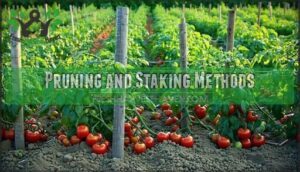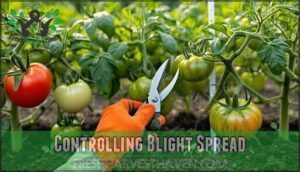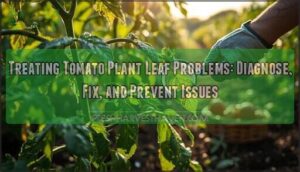This site is supported by our readers. We may earn a commission, at no cost to you, if you purchase through links.

Start with crop rotation—move your tomatoes to different spots each year since blight pathogens overwinter in soil.
Choose disease-resistant varieties whenever possible, as they’re your first line of defense.
Keep leaves dry by watering at soil level rather than overhead, and space plants properly for good air circulation.
Mulch around plants to prevent soil-borne spores from splashing onto leaves during rain.
Remove lower leaves that touch the ground, and clean up all plant debris at season’s end.
These proven methods work together like a protective shield for your garden, using smart gardening practices and good air circulation to prevent tomato blight.
Table Of Contents
- Key Takeaways
- Recognizing Tomato Blight
- Natural Prevention Methods
- Building Soil Health
- Controlling Blight Spread
- Resistant Tomato Varieties
- Frequently Asked Questions (FAQs)
- How to prevent tomato blight?
- Is homemade blight spray for Tomatoes safe?
- Can late blight kill Tomatoes?
- Can you eat tomatoes if you have blight?
- Can Tomato plants get blight?
- Can tomato blight be eradicated?
- How to prevent blight in tomatoes naturally?
- How do you make homemade solutions for tomato blight?
- What is the best homemade spray for tomato blight?
- How long should a tomato plant stay free from blight?
- Conclusion
Key Takeaways
- Rotate your crops – Move tomatoes to different garden spots each year since blight pathogens overwinter in soil and wait for their favorite host plants to return.
- Choose resistant varieties – Plant disease-resistant tomatoes like ‘Mountain Magic’ or ‘Iron Lady’ that have built-in protection against blight before you even start growing.
- Master your watering technique – Water at soil level during early morning hours to keep leaves dry, since wet foliage creates the perfect breeding ground for fungal spores.
- Create proper spacing and airflow – Space plants 3-4 feet apart, prune lower branches that touch soil, and use mulch to prevent spores from splashing onto leaves during rain.
Recognizing Tomato Blight
You’ll spot tomato blight by looking for telltale signs on your plants’ leaves, stems, and fruit. Early detection means the difference between saving your harvest and watching it disappear overnight.
Early Blight Symptoms
Spot early blight symptoms before they devastate your tomato plants.
Look for dark spots with concentric rings appearing on lower leaves first, creating a distinctive bullseye pattern.
These leaf lesions start small but expand rapidly, developing yellow halos around the edges.
Early detection prevents widespread blight progression throughout your garden.
- Target zones: Lower leaves show the first signs of infection
- Ring patterns: Dark spots display characteristic concentric rings
- Yellowing edges: Leaf spots develop bright yellow halos before browning
Late Blight Symptoms
Late blight spreads like wildfire through your tomato plants, making quick identification essential. You’ll first notice water-soaked lesions on leaves that rapidly expand into brown or dark-green patches with fuzzy white growth underneath.
Late blight turns healthy tomato plants into brown, wilted disasters overnight.
These blight symptoms progress fast, causing leaf browning and shriveling within days. Watch for fruit rot signs—tomatoes develop leathery, dark spots that spread quickly.
Plant collapse causes include stem infections that create dark, sunken areas, weakening the entire structure. The disease thrives in cool, wet conditions, spreading through airborne spores.
Identifying look-alikes matters too. Unlike early blight’s concentric rings, late blight creates irregular patches without distinct patterns. The rapid disease spread distinguishes it from other fungal issues—healthy plants can deteriorate overnight during humid weather, making quick identification and understanding of late blight symptoms crucial for tomato plants to prevent leaf browning and fruit rot.
Leaf Discoloration and Spots
You’ll notice blight symptoms first as tiny dark spots on older leaves.
Spot Size Matters – these start pinhead-small but expand rapidly.
Color Progression shows brown centers with yellow halos, while Pattern Analysis reveals circular rings in early blight.
Leaf Age Impact means lower leaves get hit first.
Environmental Factors like humidity accelerate lesion growth and leaf browning on infected leaves.
Stem Lesions and Cankers
When you examine tomato stems, dark sunken spots signal the start of canker identification. These lesions expand rapidly through lesion progression, creating weak points that can girdle stems and block nutrient flow. Understanding fungal disease patterns helps with early natural blight control.
- Monitor stems weekly for dark, sunken lesions that indicate canker development
- Practice immediate stem pruning of infected areas using sterilized tools
- Apply treatment options like copper-based fungicides or baking soda solutions
- Install plant support systems to reduce stem stress and tomato blight prevention
Fruit Symptoms
When fruit rot strikes your tomatoes, you’ll find brown, leathery spots spreading across the surface.
These infected fruit develop mushy areas that quickly deteriorate, causing uneven ripening and taste changes.
Fruit spots signal serious blight identification issues that lead to complete fruit reduction if ignored.
Early detection prevents total crop loss.
Severely affected plants may require careful plant removal to protect the rest of your crop.
Natural Prevention Methods
You can prevent tomato blight naturally by using proven methods that stop the disease before it starts.
These techniques work by creating conditions that make it harder for fungal spores to survive and spread in your garden, which is a complete approach to preventing the disease.
Crop Rotation Techniques
Through the seasons of gardening, crop rotation becomes your secret weapon against tomato blight.
This practice breaks the fungal disease cycle by moving soilborne diseases away from their favorite host plants.
Rotation families matter—swap nightshades for legumes, grains, or brassicas.
Rotation timing requires three-year gaps between tomato plantings.
Green manures like clover rebuild soil between crops.
Crop rotation benefits include:
- Your soil gets a fresh start, free from lingering pathogens
- Disease pressure drops dramatically when hosts disappear
- Rotation planning becomes easier once you establish patterns
- Nutrient depletion reverses as different plants feed the earth
- Future harvests reward your patience with healthier plants
Companion Planting Strategies
Strategic companion planting creates natural tomato disease control through beneficial herbs and pest deterrents.
Basil provides growth synergy while repelling harmful insects. Garlic’s antifungal compounds support organic tomato care.
Marigolds and nasturtiums serve as pollinator attractants and trap crops. Companion planting tomatoes with these allies enhances nutrient cycling and delivers effective natural tomato remedies against blight.
Dill attracts beneficial insects by providing essential nectar and pollen.
Organic Mulching Options
Choosing the right organic mulch sets up your tomato plants for success against blight. Straw vs Hay matters—straw won’t introduce weed seeds like hay might.
Compost Mulch and Leaf Mold feed beneficial microorganisms while blocking soil-borne spores. Wood Chips work great for pathways, though they tie up nitrogen initially.
Grass Clippings decompose quickly, adding organic matter to boost soil health. Consider using organic options for tomatoes to enhance growth.
Apply any organic mulch 2-3 inches thick around plants, keeping it from touching stems. This simple mulching strategy creates a protective barrier that stops spores from splashing onto leaves during rain—one of nature’s best natural remedies for preventing blight.
Proper Watering Techniques
After mulching protects your soil, smart watering techniques become your next defense against blight.
Water at soil level during early morning hours to prevent leaf wetness that fungi love. This timing allows foliage to dry completely before evening.
Here’s your watering strategy:
- Drip irrigation delivers water directly to roots without splashing soil onto leaves
- Consistent watering frequency prevents stress that weakens plant immunity
- Soil moisture monitoring helps you avoid overwatering that creates fungal conditions
Skip overhead watering entirely—it’s like rolling out the red carpet for blight spores.
Pruning and Staking Methods
After proper watering, pruning techniques and staking benefits work together to prevent blight.
Remove lower branches touching soil to improve air circulation around your plants. Space plants 3-4 feet apart for better airflow.
| Method | Benefits | Timing |
|---|---|---|
| Lower branch pruning | Reduces soil contact | Early season |
| Vertical growth support | Better air circulation | At planting |
| Proper plant spacing | Prevents moisture buildup | Planning stage |
Support systems like stakes or cages promote vertical growth while keeping foliage dry and healthy.
Building Soil Health
Your soil’s health directly impacts your tomato plants’ ability to resist blight naturally.
Strong soil with proper drainage, balanced pH, and rich organic matter creates an environment where beneficial microorganisms can thrive and protect your plants from fungal diseases, contributing to overall health.
Improving Soil Drainage
Good soil drainage prevents waterlogged roots that welcome blight-causing pathogens. Waterlogged soil creates the perfect breeding ground for fungal diseases, making proper drainage your first line of defense.
Poor drainage turns healthy soil for tomatoes into a soggy mess. Here’s how to fix it:
- Build raised beds 8-12 inches high for better water flow
- Install French drains in chronically wet areas
- Add drainage amendments like coarse sand or perlite to heavy clay
- Create terraced slopes to redirect excess water away from plants
- Test your water table depth before planting
These soil amendments transform compacted earth into well-draining soil composition that supports strong root systems and reduces disease pressure. Proper drainage is crucial for preventing waterlogged roots and maintaining healthy soil, which is essential for growing tomatoes in well-draining soil.
Balancing Soil PH
Your tomato plants won’t reach their full potential without proper pH balance. Soil testing methods like digital meters or test strips reveal current levels quickly.
Ideal pH levels for tomatoes range from 6.0 to 6.8, where nutrients flow freely to roots.
Amending soil naturally works best – add crushed eggshells for calcium when pH runs low, or sulfur when it’s too high.
pH impact nutrients dramatically affects plant health, making iron, phosphorus, and other essentials unavailable outside the sweet spot.
Monitoring pH changes throughout the growing season keeps your healthy soil for tomatoes performing at their best with proper soil amendments.
Adding Organic Matter
Since organic matter acts as your soil’s foundation, you’ll want to focus on compost incorporation and eggshell amendment for maximum impact.
These additions transform soil structure while boosting fertility and microbial activity.
Compost feeds beneficial organisms that strengthen disease resistance, while crushed eggshells add calcium.
You can even find specialized tomato compost products for ideal growth.
Organic fertilizers work alongside mulching to create an environment where tomato plants thrive naturally.
Beneficial Microorganisms
While organic matter feeds your soil, beneficial microorganisms transform it into a living fortress against tomato blight. These microscopic allies work around the clock, creating Mycorrhizal Networks that boost plant immunity and deliver nutrients directly to roots.
Bacillus Subtilis produces natural compounds that stop blight pathogens cold, while Trichoderma Benefits include competing with harmful fungi for space and resources. One option for managing early blight is to use Trichoderma harzianum strains as a biological control agent.
Here’s how to build your soil’s microbial army:
- Apply Compost Tea weekly during growing season
- Practice Soil Inoculation with mycorrhizal fungi
- Add Trichoderma-rich organic amendments
- Use bacterial inoculants containing Bacillus strains
- Maintain consistent moisture for microbial activity
These natural solutions create lasting disease prevention through enhanced plant health and stronger root systems.
Controlling Blight Spread
Once blight shows up in your garden, you’ll need to act fast to stop it from spreading to healthy plants.
Quick removal of infected material and proper sanitation can save your entire tomato crop from disaster.
Removing Infected Plants
Your garden’s health depends on swift action when blight strikes. Remove infected leaves immediately using protective gear to prevent spore spread.
Bag plant debris for safe disposal—never compost diseased material. This disease containment strategy maintains garden hygiene and minimizes spread.
Proper plant removal protects healthy plants while tool sanitation prevents cross-contamination throughout your garden, which is a key part of disease containment and maintaining garden hygiene, and ensuring proper plant removal.
Disinfecting Garden Tools
Clean garden tools after each use to stop blight from spreading between plants.
Tool sterilization methods like cleaning solutions (10% bleach mix) or rubbing alcohol work best. Sharpening disinfection with flame sterilization helps metal tools.
Preventing cross-contamination through proper garden sanitation keeps your tomatoes healthy. Storage practices matter too—dry tools completely before putting them away.
Smart garden hygiene practices make all the difference. Using a baking soda fungicide on tools can also help prevent the spread of fungal diseases.
Soil Solarization Techniques
Soil solarization harnesses summer heat to kill fungal diseases naturally. Place clear plastic sheeting over moist garden soil for 4-6 weeks during peak summer heat. Temperature thresholds of 120°F eliminate pathogens in the top 6 inches, improving soil management substantially.
Solarization duration depends on your climate:
- Prepare soil – Remove debris and till deeply
- Add soil moisture – Water thoroughly before covering
- Choose plastic types – Use 1-2 mil clear UV-resistant sheeting
- Seal edges – Trap heat by securing plastic tightly
- Monitor progress – Check for tears and maintain garden hygiene practices
Depth impact decreases below 12 inches, so surface pathogens suffer most.
Using Natural Fungicides
Beyond soil solarization, you can arm yourself with natural fungicides that pack a real punch against blight. Baking soda creates an alkaline barrier fungi can’t tolerate – mix one tablespoon per gallon with mild soap. Milk solution (40% milk, 60% water) provides antifungal proteins that strengthen plant defenses.
You can find various baking soda fungicides online. Neem oil disrupts fungal growth while hydrogen peroxide oxidizes spores on contact.
Apply these treatments consistently for maximum protection.
| Fungicide Type | Application Rate | Best Used For |
|---|---|---|
| Baking Soda | 1 tbsp per gallon | Early prevention |
| Milk Solution | 40% milk, 60% water | Antifungal boost |
| Neem Oil | Follow label directions | Broad protection |
| Hydrogen Peroxide | 8oz per gallon | After rain treatment |
| Copper Fungicide | Weekly light applications | Stubborn outbreaks |
Neem oil disrupts fungal growth while hydrogen peroxide oxidizes spores on contact. Apply these treatments consistently for maximum protection.
Resistant Tomato Varieties
You’ll find that choosing the right tomato varieties can cut your blight battles in half before you even plant your first seedling.
Smart gardeners know that disease-resistant varieties like ‘Mountain Magic’ and ‘Iron Lady’ offer built-in protection that saves time, money, and frustration throughout the growing season, which is a key factor in having a successful and frustration-free garden experience.
Heirloom Resistant Varieties
You’ll find heirloom tomatoes pack serious punch against blight while delivering unmatched flavor profiles.
Cherokee Purple resists bacterial speck and fusarium wilt, while Brandywine tolerates early blight beautifully.
Genetic diversity in these blight resistant varieties means stronger disease resistance through generations of regional adaptation.
Some varieties even offer nematodes resistance benefits.
Seed saving preserves these heirloom traits for future seasons, creating your own library of proven performers that taste incredible too.
Hybrid Resistant Varieties
Modern hybrid varieties pack serious disease-fighting power through advanced breeding techniques and genetic diversity.
These blight resistant varieties offer trait stability and superior yield comparison to traditional tomatoes.
Top hybrid resistant varieties deliver reliable protection:
- Iron Lady – Combines hybrid vigor with exceptional late blight resistance
- Mountain Magic – Proven performer against both early and late blight
- Jasper – Cherry variety offering dual blight protection with high yields
- Plum Regal – Perfect balance of disease resistance and productivity for processing
Grafted Tomato Plants
Grafting combines your favorite tomato varieties with disease-resistant plants through proven grafting techniques.
This rootstock selection creates superior plant resilience by merging strong roots with flavorful tops.
During the healing process, grafted plants develop robust natural defenses against soil-borne diseases.
Grafted care involves consistent watering and monitoring.
These blight resistant tomatoes deliver plant resistance that outperforms regular varieties, giving you grafting benefits that protect your harvest naturally.
Selecting Disease-Tolerant Varieties
Success stories start with smart choices when selecting disease-tolerant varieties.
You’ll want blight resistant tomatoes that match your climate and taste preferences. Smart gardeners balance hybrid vs. heirloom options, considering regional adaptability and variety lifespan alongside flavor profiles.
- Mountain Magic F1: Champion late blight fighter with extended harvest
- Iron Lady F1: Multi-disease warrior with exceptional flavor profiles
- Cherokee Purple: Heirloom heavyweight offering grafting benefits potential
- Defiant PhR F1: All-around performer balancing disease resistance and taste
Frequently Asked Questions (FAQs)
How to prevent tomato blight?
Like a castle needing strong walls against invaders, your tomato plants need defenses against fungal attacks.
Space plants 3-4 feet apart, mulch heavily, prune lower branches, water at soil level, and choose blight-resistant varieties like Mountain Magic F
Is homemade blight spray for Tomatoes safe?
Yes, homemade blight sprays are generally safe when you follow proper recipes and application guidelines.
Common ingredients like baking soda, milk, and hydrogen peroxide pose minimal risk to plants and humans when diluted correctly.
Can late blight kill Tomatoes?
Late blight can absolutely kill your tomato plants. This aggressive fungal disease moves fast, destroying leaves, stems, and fruit within days. Without quick treatment, it’ll wipe out entire plants completely.
Can you eat tomatoes if you have blight?
Don’t eat blighted tomatoes—they’re unsafe and taste terrible.
The fungus makes them bitter and potentially harmful.
However, you can eat healthy tomatoes from infected plants if they show no blight symptoms.
Can Tomato plants get blight?
Tomato troubles can strike like a thief in the night.
Your plants absolutely can get blight from fungal organisms.
Early blight creates dark spots with rings, while late blight causes water-soaked patches that spread rapidly, potentially destroying entire crops within days.
Can tomato blight be eradicated?
Unfortunately, you can’t completely eradicate tomato blight once it’s established.
However, you can manage it effectively through prompt removal of infected plant parts, proper sanitation, and preventive measures to stop its spread, which includes taking steps to prevent further infection.
How to prevent blight in tomatoes naturally?
Space your tomato plants three feet apart.
Apply organic mulch like straw around the base.
Water at soil level early morning, prune lower branches for airflow, and choose blight-resistant varieties.
How do you make homemade solutions for tomato blight?
Mix baking soda solution using 2 tablespoons baking soda, 1 tablespoon liquid soap, and 1 gallon water. You can also try milk spray with 40% milk, 60% water, or hydrogen peroxide at 7 tablespoons per gallon.
What is the best homemade spray for tomato blight?
Surprisingly, baking soda’s your best friend here!
Mix 2 tablespoons baking soda, 1 tablespoon liquid castile soap, and 1 gallon water.
This alkaline solution disrupts fungal growth naturally, giving your tomatoes fighting power they need.
How long should a tomato plant stay free from blight?
A healthy tomato plant should remain blight-free throughout the entire growing season with proper care.
You’ll want to maintain consistent prevention practices from planting through harvest to keep your plants thriving and productive.
Conclusion
Ironically, while blight seems unstoppable, you’ve got more power than you think.
When you prevent tomato blight naturally using these proven methods, you’re basically turning your garden into a fortress against fungal attacks.
Crop rotation breaks the disease cycle, resistant varieties provide built-in protection, and proper spacing creates airflow that fungi hate.
Smart watering keeps leaves dry, while mulching blocks soil-borne spores.
These simple techniques work better together than expensive chemical treatments alone.
- https://yardandgarden.extension.iastate.edu/faq/how-can-i-prevent-blight-my-tomatoes
- https://www.reddit.com/r/gardening/comments/20pu9z/how_can_i_beat_tomato_blight/
- https://www.gardentech.com/blog/pest-id-and-prevention/fight-blight-on-your-tomatoes
- https://www.gardenersworld.com/how-to/solve-problems/tomato-blight/
- https://www.teraganix.com/blogs/organic-gardening-tips/battling-tomato-blight-effective-solutions-for-healthy-harvests















